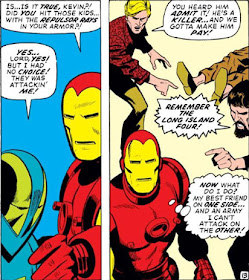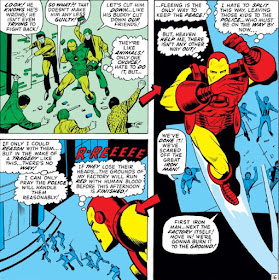Marvel has done its fair share of campus unrest stories, particularly in the late '60s and early '70s--so it's probably no surprise to find Tony Stark (and, by extension, Iron Man) coming into conflict with the violent protest movements of the time, in light of the fact that he was still primarily manufacturing munitions and hadn't yet rededicated his company's resources to research and development. Yet in a two-part story, national unrest with the Vietnam War served as the backdrop for a more personal crisis for Stark, involving his best friend--who also would be the first person to don the armored suit of the character known as the Guardsman.
(Get a good look at that campus where Iron Man is getting pelted with rotten fruit and molotov cocktails, because this story doesn't go anywhere near a campus; instead, it takes place entirely on the grounds of Stark's factory. The cover to the story's conclusion in the following issue hits much closer to the mark.)
We've become so used to seeing men in Guardsman armor "guard"ing facilities where super-villains are incarcerated that it's easy to forget that this armor has a tragic history. Designed by Stark to be used by his close friend, Kevin O'Brien, as a fail-safe measure (in conjunction with a special ship), O'Brien suits up in the armor in order to rescue an overdue Iron Man who's battling an agent of the mysterious villain known as Mister Kline.
O'Brien is successful--but there are some complications involved in "the Guardsman" (so named by O'Brien himself) becoming a character in his own right, at least for the time being. First, of course, we should keep in mind that Stark didn't create this suit with the idea of its wearer using it for anything beyond a short-term operation as needed. (Though knowing Stark, you can make a fair assumption that the Guardsman armor is still a cut above the status of a prototype.) That's all well and good, until we discover something festering within O'Brien's mind like a time bomb--the fact that he's developed feelings for Marianne Rodgers, a woman who has slowly but surely acknowledged her own feelings for Tony Stark, with Stark feeling the same. And now that O'Brien has had a taste of the armor's power, his feelings of friendship toward Stark have become conflicted, to say the least.
Unfortunately, O'Brien then overhears Stark and Marianne professing their love for each other--after which, Stark proposes marriage and Marianne accepts. (Good grief! Haven't these two ever heard of dating?) In Kevin's state of mind, it pushes him over the edge; and when the ruthless Simon Gilbert, Chairman of Stark's Board of Directors, prepares a hostile takeover of Stark Industries, Gilbert finds that he's been handed a trump card to play against Stark.
And so for better or worse, the Guardsman is finally committed as a character--though we can all probably assume that the situation will indeed become worse for him. But where does this issue's cover image fit into all of this? Iron Man, appearing to be caught in the middle of a campus war protest? The cover basically has the right idea, but the circumstances are very different. We just have to move the hostilities to a munitions factory like Stark's, a likely venue for demonstrators to target; but before Iron Man can get involved, the demonstrators are going to find themselves being confronted by another armored figure who isn't obliged to be nearly as charitable in hearing them out, thanks to Gilbert.
And if you think the Guardsman being unleashed on essentially unarmed kids is a recipe for disaster, then you're beginning to get a sense of the potentially explosive direction the story is headed in.
The plot of this story is certainly workable enough, with the situation regarding the angry actions of the demonstrators basically orbiting around O'Brien's unhinged mind as well as Iron Man's efforts to resolve both situations. Its only real shortcoming is how writer Gary Friedrich at times finds himself at odds with the panels that artist George Tuska has laid out to pace the story--with Friedrich appearing to be at a loss as to how to account for some of the scenes which Tuska has included, and his scripting consequently reading less fluidly than it should.
That said, he handles the plight of the Guardsman well enough, though his story seems to base O'Brien's difficulties in large part on his wearing of the armor--a development which Friedrich handles as if he himself isn't sure it's the direction he wants to go in. There have admittedly been other instances where the armor, worn by others, has been linked to reckless or unstable behavior--yet those are cases where other factors were involved, such as a prior brain injury (Eddie March) or subconscious feelings of guilt (Jim Rhodes). Tuska appears to be presenting the situation here as O'Brien acting solely on his jealousy, and the story could perhaps have worked on that level alone as things spiraled out of his control; but Friedrich complicates the matter unduly by including the implication that it's the Guardsman armor that has somehow adversely influenced O'Brien's judgment. (A little more on this train of thought in a bit.)
But the die is cast for O'Brien, who at this point is simply consumed by his boiled-over feelings on the matter of Stark and Marianne and wants to lash out, with Gilbert's power play readily providing him with a way to do so. But the presence of the demonstrators is something that neither Gilbert nor O'Brien counted on. For Gilbert, it's just matter of pointing his now-hired gun at the problem; but for O'Brien, it proves to be a complication that he wasn't expecting or prepared to handle. And so he falls back on adverse feelings that are already churning inside of him, and those in his way find themselves paying the price.
It's obviously now a powder keg situation that Iron Man seeks to handle, even as O'Brien makes a discrete exit (and possibly making the situation worse by appearing to flee the scene of his crime). Confusingly, we're told in the next issue that the four demonstrators that the Guardsman blasted were only wounded, though people generally don't stop breathing if they're still living. It's unclear why Friedrich would dramatically establish those four deaths only to retract them in Part Two; the violence that Friedrich and Tuska sought to escalate in Part One could just as easily have raged as a result of the Guardsman's attack, even had it proven to be nonfatal. But Part Two has its own share of confusion, as we'll discover.
Meanwhile, O'Brien has returned to Gilbert's office in a state of shock because of the deaths--only to find Gilbert supporting his actions and signing off on the Guardsman's use of deadly force, and, in the same breath, assuring O'Brien that he'll be given Iron Man's place and status once the reins of power pass to the Board. Gilbert's assurances are enough for O'Brien to return to the grounds and attempt to prevent the violence of the demonstrators from reaching the executive offices.
While Iron Man has decided to pay his own visit to Gilbert's office--presumably to look for O'Brien, though at present Iron Man has no reason to think that O'Brien and Gilbert are working together, nor does now seem the appropriate time for Iron Man to divert his focus and have it out with Stark's power-hungry Board of Directors. Regardless, the meeting leads to a confrontation with O'Brien, and it's during the resulting standoff that Iron Man forms his conclusion as to what has driven O'Brien off the deep end.
Clearly O'Brien believes his motivations for his actions are due to his resentment of Stark (in regard to Marianne in particular), rather than what Stark is assuming about the armor. Without knowing O'Brien's feelings toward Marianne, Stark is perhaps justified in leaping to his theory regarding the armor--though as the engineer who designed and built the Guardsman armor, you'd think he would have specific reasons to support that theory instead of vague references to "untested power"; he would also likely have based the Guardsman's circuitry on that of his own armor, which has exhibited no signs of causing such mental instability. (Of course with Stark, one could say the jury is arguably still out on that one.) There's just no easy answer to Friedrich's approach, one way or the other. If he had relied on only O'Brien's jealousy to drive this story, it would have been an almost jolting shift in O'Brien's character, given his friendship with Stark and the very short time that it took him to develop feelings for Marianne--quite a fast track to vengeance, in terms of the extent to which he would take such steps to deal with Stark.
By this time, the police have arrived to attempt to contain the violence of the demonstrators, and the tension is mounting as the officers try and hold their ground without responding to the taunts and bricks being hurled their way. O'Brien immediately bolts to deal the the demonstrators--but Iron Man, fearing the worst, drops the Guardsman with a repulsor blast that targets a flaw in the armor and will stun him for a few minutes while Iron Man races outside to assist with putting a stop to the violence. Part One ends with all hell threatening to break loose, despite Iron Man's efforts to calm the situation.
Given how often Iron Man has tried in this story to head off the demonstrators with pleas to stand down, perhaps someone should advise him that the way to do that is not to put it in their faces how futile their efforts are and that there's just no way they're going to prevail. (After all, how many times has he been spoken to in the same way by opponents who appeared to have the edge on him? The answer wasn't to just pack it up and go home, was it?) If his goal is to instead incite them to further violence, then congrats, he's doing a bang-up job.
NEXT:
The pulse-pounding conclusion! Iron Man vs. the Guardsman, in final battle!
PLUS: The fate of the demonstrators! (Hint: They all go home!)
 | Invincible Iron Man #45 Script: Gary Friedrich Pencils: George Tuska Inks: Vince Colletta Letterer: Artie Simek |


















No comments:
Post a Comment